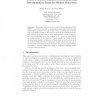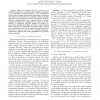1759 search results - page 160 / 352 » Using term informativeness for named entity detection |
ECCV
2006
Springer
16 years 10 hour ago
2006
Springer
This paper introduces the Located Hidden Random Field (LHRF), a conditional model for simultaneous part-based detection and segmentation of objects of a given class. Given a traini...
ITICSE
2006
ACM
15 years 4 months ago
2006
ACM
Learning elementary programming can be enhanced by introducing the notion of variable roles to students. This paper presents a web-based automatic role detection service that can ...
CIVR
2008
Springer
14 years 12 months ago
2008
Springer
Past research on automatic laughter detection has focused mainly on audio-based detection. Here we present an audiovisual approach to distinguishing laughter from speech and we sh...
102
click to vote
IJCNN
2008
IEEE
15 years 4 months ago
2008
IEEE
— Exploratory activities seem to be crucial for our cognitive development. According to psychologists, exploration is an intrinsically rewarding behaviour. The developmental robo...
ICASSP
2007
IEEE
15 years 4 months ago
2007
IEEE
Spike sorting refers to the detection and classification of electric potentials (spikes) from multi-neuron recordings, a difficult but essential pre-processing step before neura...


